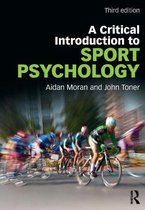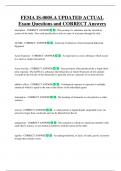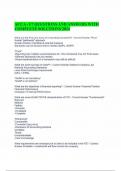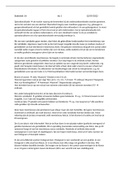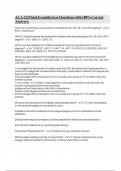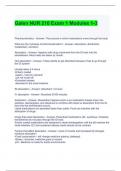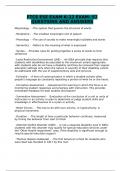Summary: a critical introduction to sport psychology
Content
Summary: a critical introduction to sport psychology............................................................................1
Chapter 1: Introducing sport psychology; Discipline and profession..................................................4
1.1 Introduction..............................................................................................................................4
1.2 The mental side of sport...........................................................................................................6
1.3 Sport psychology as an academic discipline............................................................................12
1.4 Sport psychology as a profession............................................................................................13
1.5 Current status sport psychology: respect or scepticism?........................................................17
Chapter 2: Motivation and goal-setting in sport...............................................................................19
2.1 Nature and types of motivation..............................................................................................20
2.2 Theories of motivation: from personality to cognition...........................................................21
2.3 Increasing motivation in athletes: goal-setting in sport 84.....................................................30
2.4 What motivates people to take part in high-risk sports?........................................................35
Chapter 3: ‘psyching up’ and calming down (anxiety in sport).........................................................37
3.1 Anxiety in athletes..................................................................................................................37
3.2 Measuring anxiety in athletes.................................................................................................40
3.3 Arousal, anxiety and athletic performance.............................................................................41
3.4 Controlling anxiety in sport: how do athletes and coaches cope with pressure situations?...45
Chapter 4: Emotions and Coping......................................................................................................48
4.1 What are emotions?...............................................................................................................49
4.2 Theories of emotion................................................................................................................49
4.3 Specific emotions in competitive performance......................................................................53
4.4 Measurement of emotions in athletes...................................................................................55
4.5 Emotion regulation.................................................................................................................58
4.6 Research on coping strategies of elite athletes and coaches..................................................60
4.7 Unresolved issues and new directions in research on emotions and coping in sport.............64
Chapter 5: Staying focused in sport (Concentration in sport performers)........................................65
5.1 Nature and importance of concentration in sport psychology...............................................65
5.2 Measurement of attentional processes in athletes................................................................69
5.3 Principles of effective concentration......................................................................................73
5.4 Why do athletes lose their concentration?.............................................................................73
5.5 Concentration training exercises and techniques...................................................................75
, 5.6 Old problems and new directions in research on concentration in athletes..........................79
Chapter 6: Using imagination in sport; mental imagery, motor imagery and mental practice in
athletes.............................................................................................................................................80
6.1 What is ‘mental imagery’ and how can we study it?..............................................................80
6.2 Research on mental practice (MP) in sport.............................................................................83
6.3 Athletes’ use of mental imagery.............................................................................................90
Chapter 7: What lies beneath the surface? Investigating expertise in sport....................................92
7.1 The nature and study of expertise in sport.............................................................................93
7.2 Expert-novice differences in sport: research methods and findings.......................................96
7.3 Becoming an expert athlete: Ericsson’s theory of deliberate practice....................................99
Chapter 8: Exploring team cohesion in sport: A critical perspective...............................................104
8.1 Groups, teams, and group dynamics in sport.......................................................................105
8.2 Team spirit or social cohesion: from popular understanding to psychological analysis........106
8.3 Team-building in sport..........................................................................................................113
8.4 School sports: helpful or harmful?........................................................................................117
Chapter 9: New horizons: Embodied cognition and cultural sport psychology..............................118
9.1 Origins of the cognitive paradigm in psychology..................................................................118
9.2 The embodiment approach in sport psychology: resurrecting the body to study the mind. 121
9.3 Cultural sport psychology.....................................................................................................124
9.4 Some new directions for research in cultural sport psychology...........................................125
Chapter 1: Introducing sport psychology; Discipline and profession..................................................3
1.1 Introduction........................................................................................................................3
1.2 The mental side of sport.....................................................................................................5
1.3 Sport psychology as an academic discipline.....................................................................10
1.4 Sport psychology as a profession......................................................................................12
1.5 Current status sport psychology: respect or scepticism?..................................................15
Chapter 2: Motivation and goal-setting in sport...............................................................................18
2.1 Nature and types of motivation..............................................................................................18
2.2 Theories of motivation: from personality to cognition...........................................................20
2.3 Increasing motivation in athletes: goal-setting in sport 84.....................................................29
2.4 What motivates people to take part in high-risk sports?........................................................34
Chapter 3: ‘psyching up’ and calming down (anxiety in sport).........................................................36
3.1 Anxiety in athletes..................................................................................................................36
3.2 Measuring anxiety in athletes................................................................................................39
3.3 Arousal, anxiety and athletic performance.............................................................................40
3.4 Controlling anxiety in sport: how do athletes and coaches cope with pressure situations?. .44
,Chapter 4: Emotions and Coping......................................................................................................47
4.1 What are emotions?...............................................................................................................47
4.2 Theories of emotion...............................................................................................................48
4.3 Specific emotions in competitive performance......................................................................52
4.4 Measurement of emotions in athletes...................................................................................54
4.5 Emotion regulation.................................................................................................................57
4.6 Research on coping strategies of elite athletes and coaches..................................................59
4.7 Unresolved issues and new directions in research on emotions and coping in sport.............63
Chapter 5: Staying focused in sport (Concentration in sport performers)........................................64
5.1 Nature and importance of concentration in sport psychology...............................................64
5.2 Measurement of attentional processes in athletes................................................................68
5.3 Principles of effective concentration......................................................................................71
5.4 Why do athletes lose their concentration?.............................................................................72
5.5 Concentration training exercises and techniques...................................................................74
5.6 Old problems and new directions in research on concentration in athletes..........................77
Chapter 6: Using imagination in sport; mental imagery, motor imagery and mental practice in
athletes............................................................................................................................................79
6.1 What is ‘mental imagery’ and how can we study it?..............................................................79
6.2 Research on mental practice (MP) in sport............................................................................82
6.3 Athletes’ use of mental imagery.............................................................................................89
Chapter 7: What lies beneath the surface? Investigating expertise in sport....................................91
7.1 The nature and study of expertise in sport.............................................................................91
7.2 Expert-novice differences in sport: research methods and findings.......................................94
7.3 Becoming an expert athlete: Ericsson’s theory of deliberate practice...................................98
Chapter 8: Exploring team cohesion in sport: A critical perspective..............................................103
8.1 Groups, teams, and group dynamics in sport.......................................................................103
8.2 Team spirit or social cohesion: from popular understanding to psychological analysis.......104
8.3 Team-building in sport..........................................................................................................112
8.4 School sports: helpful or harmful?........................................................................................116
Chapter 9: New horizons: Embodied cognition and cultural sport psychology..............................117
9.1 Origins of the cognitive paradigm in psychology..................................................................117
9.2 The embodiment approach in sport psychology: resurrecting the body to study the mind.120
9.3 Cultural sport psychology.....................................................................................................122
9.4 Some new directions for research in cultural sport psychology...........................................124
, Chapter 1: Introducing sport psychology; Discipline and profession
1.1 Introduction
Many prominent athletes and coaches believe that although sport is played with the body, it is won
in the mind. This idea applies both to individual and to team sports. If mental processes are crucial
for athletic success, psychologists should be able to help sports competitors to enhance their athletic
performance by providing them with practical advice on how to do their best when it matters most.
Influenced by this possibility, increasing numbers of athletes, coaches and teams have turned to
sport psychologists in an effort to gain a winning edge over their rivals. The quest to increase
psychological strength is apparent in virtually all competitive games, it is especially evident in
mentally demanding individual sports such as golf. Not surprisingly, therefore, major championship
winning golfers such as Justin Rose and Pádraig Harrington have acknowledged the contribution of
sport psychologists to their success in recent years. Interestingly, Phil Mickelson, one of the best
players in the world, has a degree in psychology. Also, D. Davies has consulted up to three sport
psychologists on a regular basis. It would be wrong, however, to assume that athlete–psychologist
consultations are always about performance enhancement. Thus Keefe suggested that one reason
why so many professional golfers hire psychologists is simply that they “need to tell their story to
someone” who has little direct involvement in their lives. Until recently, this idea that athletes have a
story to tell in order to make sense of their existence has attracted little research attention. However,
with the emergence of a new research method called narrative inquiry in sport psychology, a tool is
now available by which to elicit and analyse the “stories” of athletes’ lives. Regardless of whether its
origins are pragmatic or therapeutic, athletes’ interest in consulting psychologists is particularly
noticeable at the elite grade of sport performance where minimal differences exist between
competitors in technical ability and/or physical fitness. Perhaps more importantly, mental resilience
can be developed through appropriate practice and training. Although anecdotal, these insights into
the importance of psychological factors in sport are supported by scientific evidence. For example,
research on the “peak performance” experiences of athletes as well as in-depth interviews with
Olympic champions indicate that mental toughness and the ability to concentrate effectively are
among the factors which distinguish top athletes from less successful counterparts. But apart from
having some vague awareness of its importance to athletic success, what do we really know about
Content
Summary: a critical introduction to sport psychology............................................................................1
Chapter 1: Introducing sport psychology; Discipline and profession..................................................4
1.1 Introduction..............................................................................................................................4
1.2 The mental side of sport...........................................................................................................6
1.3 Sport psychology as an academic discipline............................................................................12
1.4 Sport psychology as a profession............................................................................................13
1.5 Current status sport psychology: respect or scepticism?........................................................17
Chapter 2: Motivation and goal-setting in sport...............................................................................19
2.1 Nature and types of motivation..............................................................................................20
2.2 Theories of motivation: from personality to cognition...........................................................21
2.3 Increasing motivation in athletes: goal-setting in sport 84.....................................................30
2.4 What motivates people to take part in high-risk sports?........................................................35
Chapter 3: ‘psyching up’ and calming down (anxiety in sport).........................................................37
3.1 Anxiety in athletes..................................................................................................................37
3.2 Measuring anxiety in athletes.................................................................................................40
3.3 Arousal, anxiety and athletic performance.............................................................................41
3.4 Controlling anxiety in sport: how do athletes and coaches cope with pressure situations?...45
Chapter 4: Emotions and Coping......................................................................................................48
4.1 What are emotions?...............................................................................................................49
4.2 Theories of emotion................................................................................................................49
4.3 Specific emotions in competitive performance......................................................................53
4.4 Measurement of emotions in athletes...................................................................................55
4.5 Emotion regulation.................................................................................................................58
4.6 Research on coping strategies of elite athletes and coaches..................................................60
4.7 Unresolved issues and new directions in research on emotions and coping in sport.............64
Chapter 5: Staying focused in sport (Concentration in sport performers)........................................65
5.1 Nature and importance of concentration in sport psychology...............................................65
5.2 Measurement of attentional processes in athletes................................................................69
5.3 Principles of effective concentration......................................................................................73
5.4 Why do athletes lose their concentration?.............................................................................73
5.5 Concentration training exercises and techniques...................................................................75
, 5.6 Old problems and new directions in research on concentration in athletes..........................79
Chapter 6: Using imagination in sport; mental imagery, motor imagery and mental practice in
athletes.............................................................................................................................................80
6.1 What is ‘mental imagery’ and how can we study it?..............................................................80
6.2 Research on mental practice (MP) in sport.............................................................................83
6.3 Athletes’ use of mental imagery.............................................................................................90
Chapter 7: What lies beneath the surface? Investigating expertise in sport....................................92
7.1 The nature and study of expertise in sport.............................................................................93
7.2 Expert-novice differences in sport: research methods and findings.......................................96
7.3 Becoming an expert athlete: Ericsson’s theory of deliberate practice....................................99
Chapter 8: Exploring team cohesion in sport: A critical perspective...............................................104
8.1 Groups, teams, and group dynamics in sport.......................................................................105
8.2 Team spirit or social cohesion: from popular understanding to psychological analysis........106
8.3 Team-building in sport..........................................................................................................113
8.4 School sports: helpful or harmful?........................................................................................117
Chapter 9: New horizons: Embodied cognition and cultural sport psychology..............................118
9.1 Origins of the cognitive paradigm in psychology..................................................................118
9.2 The embodiment approach in sport psychology: resurrecting the body to study the mind. 121
9.3 Cultural sport psychology.....................................................................................................124
9.4 Some new directions for research in cultural sport psychology...........................................125
Chapter 1: Introducing sport psychology; Discipline and profession..................................................3
1.1 Introduction........................................................................................................................3
1.2 The mental side of sport.....................................................................................................5
1.3 Sport psychology as an academic discipline.....................................................................10
1.4 Sport psychology as a profession......................................................................................12
1.5 Current status sport psychology: respect or scepticism?..................................................15
Chapter 2: Motivation and goal-setting in sport...............................................................................18
2.1 Nature and types of motivation..............................................................................................18
2.2 Theories of motivation: from personality to cognition...........................................................20
2.3 Increasing motivation in athletes: goal-setting in sport 84.....................................................29
2.4 What motivates people to take part in high-risk sports?........................................................34
Chapter 3: ‘psyching up’ and calming down (anxiety in sport).........................................................36
3.1 Anxiety in athletes..................................................................................................................36
3.2 Measuring anxiety in athletes................................................................................................39
3.3 Arousal, anxiety and athletic performance.............................................................................40
3.4 Controlling anxiety in sport: how do athletes and coaches cope with pressure situations?. .44
,Chapter 4: Emotions and Coping......................................................................................................47
4.1 What are emotions?...............................................................................................................47
4.2 Theories of emotion...............................................................................................................48
4.3 Specific emotions in competitive performance......................................................................52
4.4 Measurement of emotions in athletes...................................................................................54
4.5 Emotion regulation.................................................................................................................57
4.6 Research on coping strategies of elite athletes and coaches..................................................59
4.7 Unresolved issues and new directions in research on emotions and coping in sport.............63
Chapter 5: Staying focused in sport (Concentration in sport performers)........................................64
5.1 Nature and importance of concentration in sport psychology...............................................64
5.2 Measurement of attentional processes in athletes................................................................68
5.3 Principles of effective concentration......................................................................................71
5.4 Why do athletes lose their concentration?.............................................................................72
5.5 Concentration training exercises and techniques...................................................................74
5.6 Old problems and new directions in research on concentration in athletes..........................77
Chapter 6: Using imagination in sport; mental imagery, motor imagery and mental practice in
athletes............................................................................................................................................79
6.1 What is ‘mental imagery’ and how can we study it?..............................................................79
6.2 Research on mental practice (MP) in sport............................................................................82
6.3 Athletes’ use of mental imagery.............................................................................................89
Chapter 7: What lies beneath the surface? Investigating expertise in sport....................................91
7.1 The nature and study of expertise in sport.............................................................................91
7.2 Expert-novice differences in sport: research methods and findings.......................................94
7.3 Becoming an expert athlete: Ericsson’s theory of deliberate practice...................................98
Chapter 8: Exploring team cohesion in sport: A critical perspective..............................................103
8.1 Groups, teams, and group dynamics in sport.......................................................................103
8.2 Team spirit or social cohesion: from popular understanding to psychological analysis.......104
8.3 Team-building in sport..........................................................................................................112
8.4 School sports: helpful or harmful?........................................................................................116
Chapter 9: New horizons: Embodied cognition and cultural sport psychology..............................117
9.1 Origins of the cognitive paradigm in psychology..................................................................117
9.2 The embodiment approach in sport psychology: resurrecting the body to study the mind.120
9.3 Cultural sport psychology.....................................................................................................122
9.4 Some new directions for research in cultural sport psychology...........................................124
, Chapter 1: Introducing sport psychology; Discipline and profession
1.1 Introduction
Many prominent athletes and coaches believe that although sport is played with the body, it is won
in the mind. This idea applies both to individual and to team sports. If mental processes are crucial
for athletic success, psychologists should be able to help sports competitors to enhance their athletic
performance by providing them with practical advice on how to do their best when it matters most.
Influenced by this possibility, increasing numbers of athletes, coaches and teams have turned to
sport psychologists in an effort to gain a winning edge over their rivals. The quest to increase
psychological strength is apparent in virtually all competitive games, it is especially evident in
mentally demanding individual sports such as golf. Not surprisingly, therefore, major championship
winning golfers such as Justin Rose and Pádraig Harrington have acknowledged the contribution of
sport psychologists to their success in recent years. Interestingly, Phil Mickelson, one of the best
players in the world, has a degree in psychology. Also, D. Davies has consulted up to three sport
psychologists on a regular basis. It would be wrong, however, to assume that athlete–psychologist
consultations are always about performance enhancement. Thus Keefe suggested that one reason
why so many professional golfers hire psychologists is simply that they “need to tell their story to
someone” who has little direct involvement in their lives. Until recently, this idea that athletes have a
story to tell in order to make sense of their existence has attracted little research attention. However,
with the emergence of a new research method called narrative inquiry in sport psychology, a tool is
now available by which to elicit and analyse the “stories” of athletes’ lives. Regardless of whether its
origins are pragmatic or therapeutic, athletes’ interest in consulting psychologists is particularly
noticeable at the elite grade of sport performance where minimal differences exist between
competitors in technical ability and/or physical fitness. Perhaps more importantly, mental resilience
can be developed through appropriate practice and training. Although anecdotal, these insights into
the importance of psychological factors in sport are supported by scientific evidence. For example,
research on the “peak performance” experiences of athletes as well as in-depth interviews with
Olympic champions indicate that mental toughness and the ability to concentrate effectively are
among the factors which distinguish top athletes from less successful counterparts. But apart from
having some vague awareness of its importance to athletic success, what do we really know about

